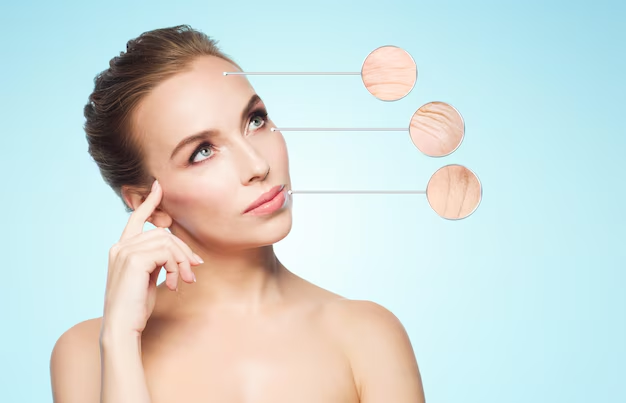
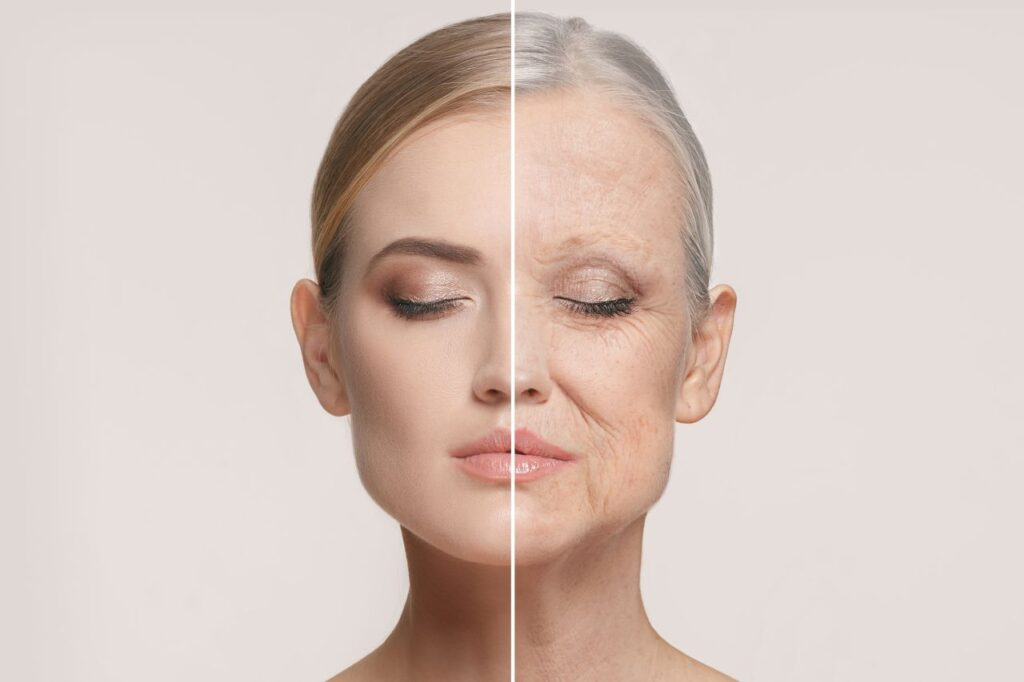
ELASTICITY AND FIRMNESS
Collagen and elastin are vital structural proteins that provide the framework for the body’s tissues, including the skin. Specific genes influence the formation and maintenance of these proteins, and genetic variations can affect how quickly this structure deteriorates. Fortunately, proper nutrition and targeted treatments can help repair and maintain these proteins. Single Nucleotide Polymorphisms (SNPs), which are genetic variations, can influence aging processes. We examine SNPs linked to aging, including their roles in processes such as glycation, where sugar molecules bind to structural proteins, compromising elasticity and firmness.
WHY DO WE EXPERIENCE LOOSE SKIN?
Loose or sagging skin results from two primary age-related factors:
- Loss of collagen, which provides elasticity.
- Loss of facial fat, which supports the skin and prevents drooping.
External factors such as sun exposure, high dietary sugar intake, and exposure to harmful chemicals (e.g., smoking) can accelerate skin aging and promote wrinkling. These environmental factors weaken skin’s structural proteins, making them brittle and prone to breakdown, resulting in sagging and the formation of wrinkles.
As we age, thinner and drier skin, along with visible lines, are natural changes largely influenced by genetics. While the aging process itself is inevitable, understanding genetic predispositions allows for personalized strategies to slow premature aging. Collaborating with a dermatologist, you can develop targeted treatments to reduce and prevent wrinkles based on your genetic profile.
TIPS:
Wrinkling
- Risk: If your genotype indicates a high risk of premature wrinkles due to elevated MMP and EDEM1 activity.
- Solutions:
- Facial exercises and creams promoting collagen production.
- Use Vitamin C to combat oxidative damage.
- Apply retinol or ascorbic acid to inhibit MMP activity and support skin structure.
Eye Laxity
- Risk: If your genotype suggests a higher likelihood of developing eye laxity, leading to drooping eyelids and surrounding skin.
- Solutions:
- Incorporate Vitamin C and Vitamin D to stimulate collagen and elastin production.
- Maintain a protein-rich, balanced diet to support skin repair.
- Use sunglasses to protect against sun damage, as early protection is key to preventing laxity.
Skin Glycation
- Risk: If your genotype is associated with an increased risk of glycation, which damages skin proteins.
- Solutions:
- Reduce sugar and simple carb intake to lower blood sugar levels and glycation risks.
- Use skincare products containing green tea, known to reduce glycation and promote collagen production.
By incorporating these strategies into your skincare routine, you can enhance skin health and resilience while addressing specific genetic vulnerabilities.
SKIN CONDITIONS
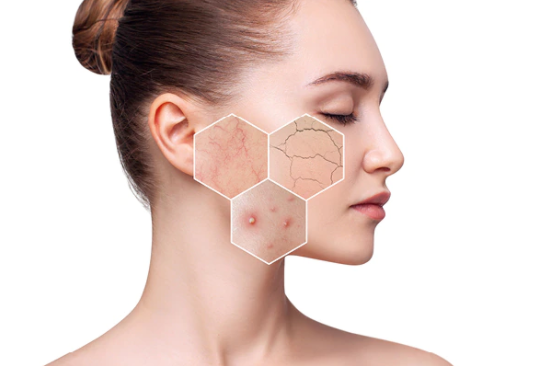
Keeping Your Skin Hydrated
Hydration is essential for maintaining healthy skin. Certain genes influence how your body transports water and glycerol, a substance that helps retain moisture. People genetically predisposed to dry skin can benefit from products that provide hydration, essential vitamins, and stimulate natural oil production to maintain moisture levels.
Understanding Oil Production
While some oil is necessary to keep skin hydrated, excess oil can clog pores, creating an environment conducive to bacterial growth and infections that lead to blemishes and pimples. The production of oil is closely linked to the hormone dihydrotestosterone (DHT), with higher circulating levels of DHT often resulting in increased oil production.
What is Combination Skin?
Combination skin, often referred to as “T-zone skin,” is characterized by oily areas with large pores on the forehead, nose, and chin, while the cheeks and areas under the eyes may feel dry or flaky. Harsh or drying products—such as those containing sulfates or alcohol—used to treat oily areas can exacerbate dryness elsewhere, prompting the skin to overcompensate with more oil production in the T-zone, creating a challenging cycle.
TIPS:
Hydration
If your genotype suggests efficient water transport and glycerol production, which means your skin retains moisture well. However, using a quality moisturizer can further enhance hydration and prevent dryness.
Oil Production
If you are genetically predisposed to a moderate increase in oil production, then to manage this:
- Use blotting papers and cosmetic clays daily to absorb excess oil before it clogs pores.
- Skincare products with ingredients like oatmeal or honey can help retain moisture while controlling oil levels.
Acne
If your genotype indicates a higher risk of acne, then to reduce breakouts:
- Use facial cleansers formulated to keep pores and hair follicles clear.
- Incorporate probiotics (both viable and non-viable) into your routine to balance your skin microbiome and address bacteria that may cause acne.
By tailoring your skincare routine to your genetic predispositions, you can achieve better hydration, balanced oil levels, and improved overall skin health.
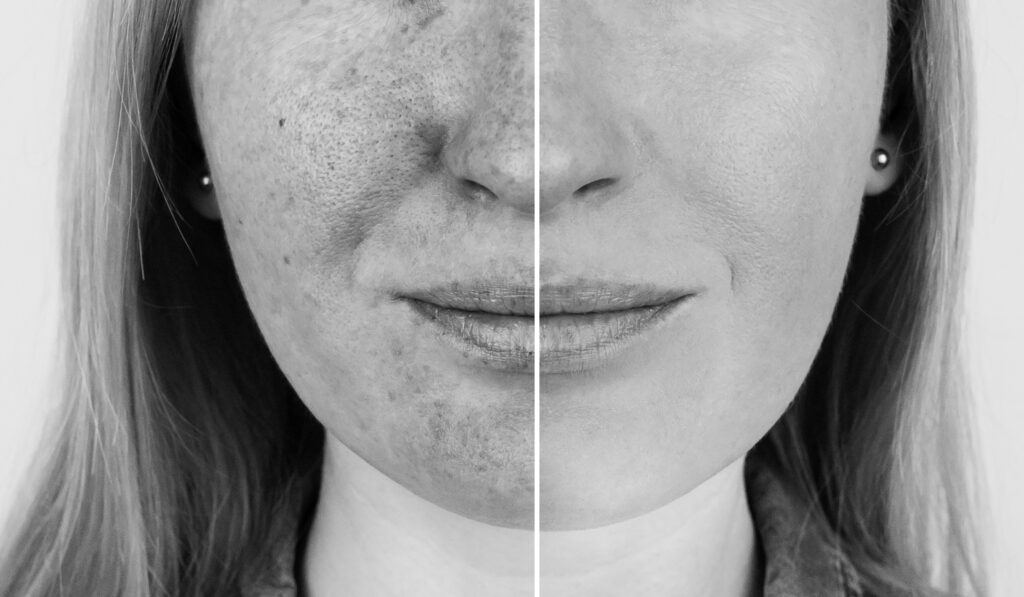
PHOTOAGING & SKIN SENSITIVITY
Your skin’s response to external stimuli, such as chemicals, toxins, and UV light, is influenced by your genetic makeup. These factors play a significant role in determining skin sensitivity, risk of inflammation, and the development of fine lines and wrinkles, including crow’s feet. Tissue damage from environmental factors can accelerate the formation of wrinkles, particularly around the eyes and mouth.
TIPS:
Skin Sensitivity
If your genotype suggests a medium risk of irritation and inflammation caused by environmental toxins and chemicals, then to manage this:
- Use soothing creams with moisturizers and aloe vera to calm irritated skin.
- Avoid using harsh products like retinoid creams during flare-ups until the skin heals.
Sun Sensitivity
If you are genetically predisposed to a higher risk of sun-related damage and developing lentigines (dark spots), then to protect your skin:
- Wear tightly woven clothing that blocks light and provides maximum coverage.
- Use sunscreen with an SPF of at least 50, which blocks 98% of UV rays.
- Opt for a wide-brim hat (not a baseball cap) to shield your neck, ears, eyes, forehead, nose, and scalp.
- Wear UV-absorbent sunglasses and limit sun exposure whenever possible.
Inflammation
With a higher genetic risk of skin inflammation, your skin may be prone to rashes, irritation, and stinging sensations. To reduce inflammation:
- Avoid products containing fragrances, as these can worsen dermatitis.
- Use lukewarm water instead of hot water, which strips the skin of natural oils and increases irritation risk.
Crow’s Feet
If your genotype shows a slightly increased risk of developing crow’s feet, then to minimize fine lines:
- Use anti-wrinkle creams with active ingredients like retinoids, coenzyme Q10, and kinetin.
- Incorporate facial exercises to strengthen connective tissue and reduce wrinkle appearance.
By understanding your genetic predispositions, you can create a tailored skincare routine that minimizes risks, protects your skin, and promotes long-term health.

VITAMINS & ANTIOXIDANTS
Antioxidants and vitamins are naturally occurring substances that can protect your skin cells. Antioxidants help build defenses against free radicals caused by UV rays and toxins. Meanwhile, Vitamin A (including retinoids) improves conditions such as oily skin, wrinkles, and acne. Vitamin D plays a crucial role in constant skin renewal. These nutrients are also known for their ability to prevent and treat certain cancers. Many skincare products—both over-the-counter and prescription—incorporate these powerful ingredients.
TIPS:
Antioxidants
If your genotype suggests a higher ability to naturally produce antioxidants. This is excellent news, as it means your skin is better equipped to defend against sun damage and toxin-related harm, then to further enhance these defenses:
- Include antioxidant-rich foods in your diet, such as cranberries or blackberries.
- Use skincare products like face masks or collagen-repair creams to target additional aspects of skin health.
Vitamin A
If your genetic profile indicates increased difficulty converting plant-based Vitamin A into its active form, then to address this:
- Consume more foods rich in active Vitamin A, such as organic butter, eggs, fish, and liver.
- Consider using Vitamin A creams for direct supplementation.
Vitamin D
If your genotype shows a tendency toward lower levels of circulating Vitamin D, then to boost your levels:
- Incorporate Vitamin D3-rich foods like egg yolks and beef liver into your diet.
- Aim for 25–30 minutes of sun exposure daily, while taking precautions to prevent sun-related skin damage.
By integrating these practices into your routine, you can optimize your skin’s health and resilience.
Skin Care for Your 40s and 50s
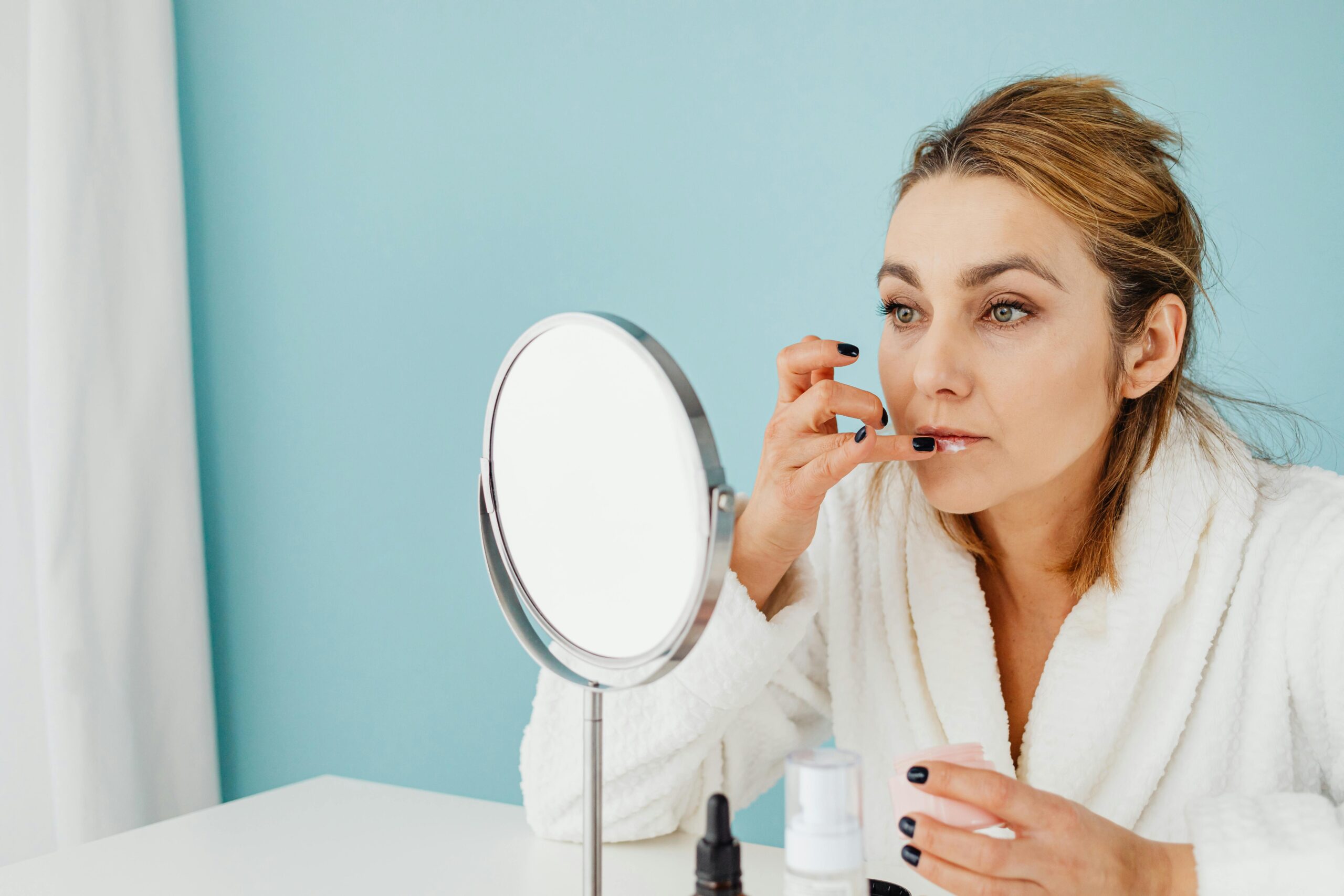
Wrinkle creams, eye serums, and other anti-aging products can help reduce signs of aging. However, the foundation of an effective anti-aging routine lies in developing healthy skin care habits. These habits not only complement your products but also provide long-term benefits, such as:
- Preventing or clearing up a blotchy complexion
- Keeping skin firm and youthful for longer
- Reducing fine lines and wrinkles
- Brightening your complexion
- Avoiding leathery skin
- Lowering the risk of skin cancer
Here are dermatologist-backed tips to help you create a solid anti-aging skin care plan:
1. Protect Your Skin from the Sun
Sun protection is the cornerstone of any anti-aging strategy. Overexposure to UV rays accelerates skin aging, a phenomenon known as “photoaging.” To shield your skin:
- Seek Shade: Stay out of the sun between 10 a.m. and 2 p.m., or when your shadow is shorter than you are.
- Dress Smart: Wear wide-brimmed hats, long sleeves, pants, and gloves to protect your hands from age spots. Sunglasses reduce fine lines around the eyes.
- Use Sunscreen Daily: Apply a broad-spectrum sunscreen with SPF 30 or higher and water resistance to all exposed skin. Reapply as needed.
- Avoid Tanning: Skip tanning beds and sun lamps, which emit harmful UV rays that speed up aging.
2. Moisturize Daily
As skin ages, it loses moisture, leading to dryness and the appearance of fine lines. Moisturizers help lock in hydration, giving your skin a smoother, more youthful look. For best results, use:
- Facial Moisturizer: For your face and neck.
- Body Moisturizer: For the rest of your skin.
- Lip Balm: To keep lips soft and hydrated.
3. Wash Your Skin Gently
How you cleanse your face matters. Overwashing or using harsh products can damage your skin. To maintain a fresh and youthful appearance:
- Use warm water and a gentle, non-soap cleanser.
- Avoid scrubbing or over-exfoliating, which can irritate the skin.
- Cleanse your face twice daily to remove dirt, oil, and makeup.
4. Quit Smoking
Smoking accelerates skin aging by exposing it to toxins that damage collagen and elastin. Over time, this leads to “smoker’s face,” characterized by:
- Dull, dry complexion
- Loss of firmness
- Premature lines and wrinkles
- Leathery skin
Quitting smoking can prevent further damage and improve your skin’s health.
5. Eat a Balanced Diet
A nutrient-rich diet can do wonders for your skin. Focus on:
- Fruits and Vegetables: Packed with antioxidants to fight skin damage.
- Lean Proteins: To support skin repair and renewal.
- Healthy Fats: Like omega-3s from fish, nuts, and seeds, which keep skin hydrated.
6. Get Your Beauty Sleep
Sleep allows your body, including your skin, to repair and regenerate. Aim for 7–9 hours of quality rest each night to wake up with refreshed, glowing skin.
Skin Care for Your 60s and 70s

As you get older, your skin changes—it becomes drier, thinner, and more easily irritated. The good news? With the right care, you can improve the look and feel of your skin, even in your 60s and 70s. Dermatologists recommend simple, gentle routines to keep your skin healthy and comfortable.
Daily Skincare Tips
- Cleansing: Use a gentle, fragrance-free soap or cleanser with moisturizing ingredients like glycerin or hyaluronic acid. Stick to warm water (not hot) and keep baths or showers short—just 5–10 minutes.
- Moisturizing: After bathing, pat your skin dry, leaving it slightly damp. Apply a creamy, fragrance-free moisturizer right away to lock in moisture. For very dry skin, an ointment may work better than a cream.
Indoor Environment Care
- Humidity: Use a humidifier to keep indoor air at 45%–60% humidity, especially in winter.
- Sun Protection: Even indoors, protect your skin from UV rays. Apply a broad-spectrum sunscreen with SPF 30+ daily and wear protective clothing like wide-brimmed hats and UV-blocking sunglasses. Avoid direct sunlight between 10 a.m. and 2 p.m.
Fragrance-Free Products and Protection
- Choose “fragrance-free” products instead of “unscented” ones to avoid hidden irritants.
- Use gloves during housework or gardening to shield your hands from chemicals and the environment.
- Avoid bath oils—they don’t hydrate much and can make your tub slippery.
Special Care for Aging Skin
- Thin Skin: Use heavier moisturizers and avoid harsh exfoliants or abrasive tools like bath brushes.
- Bruising: Handle your skin gently to prevent bruising.
- Healing: Take care to avoid cuts or scrapes, as healing takes longer with age.
When to See a Dermatologist
If you notice persistent irritation, unusual spots, or changes in your skin, consult a dermatologist. They can provide tailored solutions, from advanced moisturizers to treatments for wrinkles or age spots.
By following these tips and seeking professional advice when needed, you can keep your skin healthy, comfortable, and resilient as you age.
